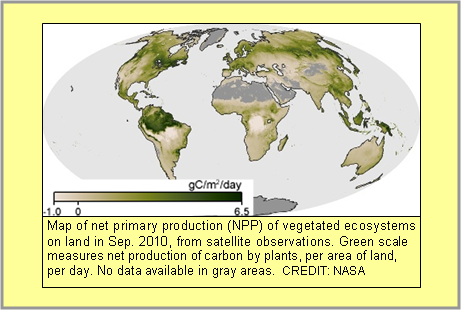
|
|||||
|
|||||
| Increasing Drought now Limits Global Water Cycle | |||||
|
|||||
|
Living plants also put water vapor into the air in a process known as transpiration. We include transpiration when we discuss global evaporation. The water cycle is completed when water precipitates as rain or snow, and returns to lakes, rivers and the sea. Climatologists anticipated that the pace of the global water cycle would pick up as the Earth, on average, warms up. Jung’s team attributes the remarkable turnaround of the water cycle since 1998 to drought in Australia and parts of Africa. Satellite observations show that soil moisture has declined in these regions and in Argentina since 1998. If the evaporation rate (from land) continues to decline, for lack of available water, it may mean that the speedup of the global hydrological cycle is limited, and the limit may have been reached. If so, the productivity of vegetation on land (including agriculture) may also be limited, as well as the ability of forests to sequester carbon. There are more unpleasant effects. When moisture is limited, less solar energy is absorbed in the evaporation of water, and more energy is available to warm the lower atmosphere. That ramps up the rate of warming at the surface – which is why Arizona heats up so much more than Florida on a summer day. In another study2 this year, University of Montana scientists Maosheng Zao and Steven Running looked at the global trend of “net primary production” (NPP), which measures the productivity of all vegetation on land (see map above). NPP is a measure of the amount of organic carbon that land plants have produced, mainly through photosynthesis; it excludes the carbon that plants respire to maintain their own life. As the growing season became longer in a warming world, and as carbon dioxide levels rose (CO2 stimulates plants to grow more biomass), many expected that the NPP index would increase. Indeed it has increased in the Northern Hemisphere. With Alaska, Canada and Russia comprising a large area of land, the Northern Hemisphere continents experience an average of 125 days of snow cover per year. Climate warming in these northern regions has led to longer growing seasons. Productivity as measured by NPP thus has increased in the Northern Hemisphere. Yet the high-latitude and high-elevation lands where NPP did increase still account for only 24% of the globe’s vegetated land area, much of it in the tropics. In the Southern Hemisphere, by contrast, warmer climates led to much greater evaporation and much less water available to plants. There is not much land with snow cover south of the equator, in proportion to the extensive forested acreage in tropical South America and Africa. Thus warmer temperatures had little effect on the length of the already-long growing season. Zhao and Running used the Palmer Drought Severity Index as an indirect measure of water available to plants; a low value generally indicates drought. South of the equator, the Palmer Index was well correlated with net primary productivity: low (dry) values of the Index were associated with low vegetative productivity. But north of the equator, the correlation was weak. The drying trend in the Southern Hemisphere overwhelmed the positive influence of the longer growing season in the Northern Hemisphere; so that over the whole Earth, net primary productivity has decreased since 2000. Severe regional droughts have been more frequent. If the drying trend continues, the consequences include less capacity to sequester carbon on land, less ability to produce biofuels, and a less secure food supply. CITATIONS 1. “Recent decline in the global land evapotranspiration trend due to limited moisture supply” by Martin Jung and 32 co-authors, Nature, vol. 467, pg. 951–954, 21 October 2010. doi: 10.1038/nature09396. 2. “Drought-Induced Reduction in Global Terrestrial Net Primary Production from 2000 through 2009” by Maosheng Zhao and Steven W. Running, Science, vol. 329, pg. 940-943, 20 Aug. 2010. |
|||||
|
|||||
